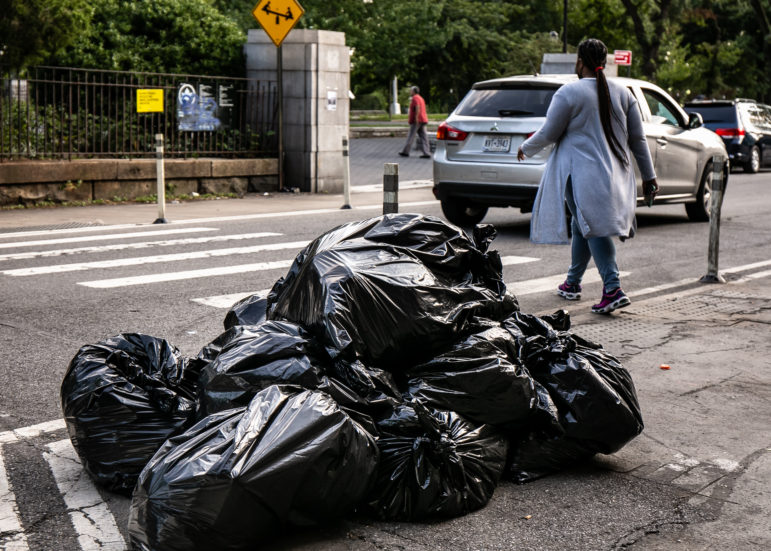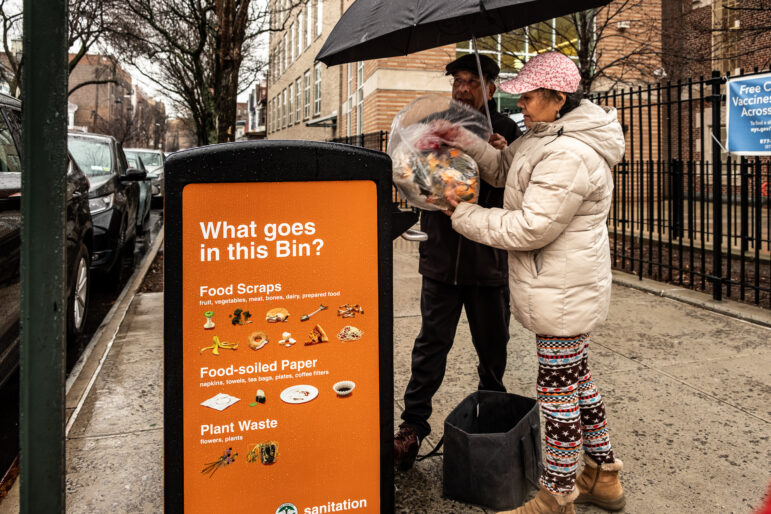“Addressing New York City’s organic waste output isn’t just about keeping our streets rodent free. It’s about communities across the country where our waste ends up in polluting incinerators and towering landfills, including the largest in the state: Seneca Meadows.”

Adi Talwar
New York City’s waste ends up “ends up in polluting incinerators and towering landfills,” the authors’ write.This year, big changes are coming to the way we’ve collected trash in New York City for the last half-century.
As part of the war on rats, the City Council’s “Rat Action Plan” represents a first salvo to reduce the amount of trash New Yorkers must navigate on the streets. The legislation requires the city to establish rat mitigation zones, mandates annual Health Department reporting, requires some large buildings to use rodent-proof trash bins, and sets new rodent management requirements for major private construction projects.
No other city in the country manages residential trash the way we do: we have bags filled with food that sit out all night and well into the morning that are ripped open by rats. It doesn’t make any sense, which is why these bills will be a welcome change when they’re implemented.
But it’s not enough.
If we want to truly reduce the number of rats roaming the streets, we also need to get serious about diverting organic waste and reducing our overall waste—including the food scraps rats love—and investing in citywide composting efforts. The pilot composting program in Queens, the first boroughwide composting project which recently ended, was incredibly successful.
But addressing our organic waste output isn’t just about keeping our streets rodent free. It’s about communities across the country where our waste ends up in polluting incinerators and towering landfills, including the largest in New York state: Seneca Meadows.

Adi Talwar
Husband and wife Manuel, 70, and Melida Peraza, 68, dropping off compostable waste at a smart bin in the Bronx.READ MORE: Sanitation Department Adds 200 ‘Smart Bins’ in NYC’s Latest Composting Expansion
Seneca Meadows—based in the idyllic town of Seneca Falls, known as the birthplace of women’s rights in the U.S.—is a 30-story-tall skyscraper of garbage, nearly a quarter of which comes from New York City alone. The landfill emits a putrid odor that threatens the region’s multi-billion dollar agritourism industry, which the state has poured millions of taxpayer dollars into supporting.
The landfill produces 75 million gallons of leachate containing toxic PFAS or “forever chemicals” annually. A third of that leachate is treated, but the rest is sent untreated to Watertown, Steuben County, Chittenango, and Buffalo—which may or may not be testing and removing PFAS before it ends up in waterways that may serve as drinking water sources.
PFAS chemicals are found in many everyday products including GORE-TEX, non-stick pans, popcorn bags, plastics, and more. Instead of breaking down, they build up in the environment and in our bodies, often entering through drinking water sources contaminated by landfills. Exposure to PFAS is linked to harmful health impacts such as cancer, liver damage, decreased fertility, increased risk of asthma and thyroid disease, to name a few. Landfills are one of the four biggest contributors to PFAS contamination, as well as huge producers of greenhouse gas emissions, including methane, which accelerates climate change.
Seneca Meadows landfill was originally supposed to close by 2025, but now the for profit company that operates it wants to expand seven-stories and to continue operating through 2040. It’s clear that New York City must seriously reduce the amount of waste we produce not only for our own good, but for the good of everyone else who has to deal with the immediate repercussions of our waste across New York State and beyond.
At the New York City Council, we’ve put forth the Zero Waste Act, a package of bills to mandate universal composting and codify the goal of zero waste to landfills and incinerators by 2030. However, the burden can’t all be on New York City. The state has a huge role to play, and it must step up by providing a comprehensive zero waste plan and supporting organics processing facilities. According to recent reporting by New York Focus, the state rolled out a vision in 2010 to reduce the daily garbage produced per person from more than four pounds in 2010 to just half a pound in 2030. But instead of staying on track, we now produce more daily garbage per person —five pounds per day—than when the plan was laid out 12 years ago.
Despite this setback, Gov. Kathy Hochul recently vetoed a bill to set a goal for New York to reduce, reuse, recycle or compost 85 percent of the state’s waste by 2032. The bill would have required the Department of Environmental Conservation to come up with a proposal to meet that bar by 2025. We need the legislature and the governor to work together and make this a priority for the state, rather than burdening local municipalities to come up with solutions town by town.
Last year, New Yorkers overwhelmingly voted in support of a constitutional right to clean air and clean water, and achieving that requires figuring out better solutions for waste across the state.
While New York City is making big moves to try to reduce the pest population, we need to get even more aggressive about reducing waste overall. It’s not only crucial to winning the war on rats, but critical to the health and safety of our neighboring communities and the planet we all share.
Anna Kelles is a member of the New York State Assembly, and sponsor of a bill to regulate “forever chemicals” in landfills. Sandy Nurse is a New York City Council member representing Brooklyn who chairs the Council’s Committee on Environmental Protection.









One thought on “Opinion: Reducing the City’s Waste Output is Good for New York State”
Composting programs have failed twice before in recent years so of course the DSNY is going for strike-3. Don’t buy the DSNY line that the compost bins won’t stink because they surely will, which is why I won’t be using one on my property. NYC has no legal authority to mandate organics separation and collection.